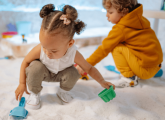Developing children’s gross and fine motor skills is essential preparation for mark-making. Here, Reception teacher Vikki Fenton gives 20 of her best tried-and-tested mark making EYFS activities…
Cast your mind back to the halcyon days before children spent too much time staring at screens of all sizes. Whether you were a child or adult back then, recall the days of playing at the park, singing, dancing to nursery rhymes and colouring in.
All of these innocent childhood pasttimes served to develop little minds but also to strengthen bodies and little fingers, ready for the joys of mark-making.
Today, it’s all too common for children to arrive in school having never held a pen, pencil or paintbrush. Many have not learnt to put on their shoes and coats independently, let alone acquired the co-ordination and dexterity to be able to fasten zips and buttons.
So, what can we do about it? The key to preparing children for mark-making, among other things, is to develop gross motor skills and fine motor skills. Here are some tried-and-tested activities for each.
Only your thumbs get exercised when you’re spending lots of time in front of a screen. How can we encourage children to get their whole body moving and develop those much-needed gross motor skills? Here are ten of the best activities to try:
PE sessions: throwing, catching, kicking and balancing all increase wellbeing, fitness and confidence, as well as gross motor skills.
Obstacle courses: hopping along, jumping over, crawling under, wriggling through. Seeing who can do it the fastest adds a certain challenge to engage those who relish a little competition.
Wheels: be they bicycles, tricycles or standalone pedals, these toys improve balance and core strength.
Dance: ribbons, fabric or streamers really encourage children to move their whole bodies as they dance. They’re also a perfect way to warm up when it’s chilly outdoors.
Digging: in sand, soil or gravel, digging is a work-out for the whole body and provides a real sense of satisfaction and achievement when finished.
Den building: channelling their inner Bear Grylls, creating a palace or even digging a rabbit’s burrow for Little Rabbit Foo Foo – these all develop gross motor skills along with planning, teamwork, and resilience.
Climbing equipment: this might be a horizontal scramble across pupil-built or adult-built piles or up and over “walls” or more permanent structures. Children’s bravery and determination will develop alongside their co-ordination.
Balance board: these are trickier than they look, and aching stomach muscles certainly remind you what you have been playing on, as our headteacher can attest!
Action songs: these are enjoyed equally indoors and outdoors in groups of any size. Our current favourites are Head, Shoulders, Knees and Toes and One Finger, One Thumb, Keep Moving.
Balls: provide them in all shapes and sizes to roll, throw, catch and chase. Throwing a ball in the air, to a partner or at a target (which could be numbers or letters) all strengthen gross motor skills and are enormous fun.
Preparing children for mark-making requires well-developed fine motor skills. Here are ten of our best activities to develop them:
Messy play: use shaving foam, icing sugar, sand, glitter, salt – anything that the children can mark-make in using their magic fingers or a tool.
Tweezers: we provide tweezers of all shapes and sizes for children to use to pick up very small parts. Right now, children are picking up beads to complete the missing parts of pictures.
Dough: make playdough of all colours – sometimes with things hidden inside to “discover”. Children can roll it, shape it, stretch it, cut it and build with it; all the while strengthening hand and arm muscles.
Padlocks and keys: arguably this is a life skill in addition to developing fine motor skills. Who hasn’t found themselves struggling to open a pesky padlock? Matching keys and locks, using colours, numbers or phonics, adds an extra dimension too.
Cutting: cut out shapes, leaves or strips of paper, or just cut for the satisfying snip. This is a popular activity in our setting.
Natural objects: our children love anything that includes natural objects: from hammering golf tees into pumpkins at Halloween and hole-punching leaves, to making bird feeders out of cereal hoops and pipe cleaners to hang on our trees.
Pipettes: children love squirting pipettes in the water tray as well as using them to paint with. We created some amazing firework pictures using pipettes.
Makaton: this obviously has multiple benefits in a school where most children have EAL, like ours. But Makaton also develops fine motor skills as children – and staff – learn to communicate using their hands.
Threading: thread any material into any receptacle; from traditional thread into binka and pipe cleaners into colanders to bright strips of fabric into carrot sacks.
Drawing: we use pencil crayons, wax crayons, felt tips and brushes to mark make onto paper, walls, floors, wipe-clean boards and more. We draw on our own or together, in the art area, in the home corner or in our small world section.

Sand and water table – Getting hands-on with maths
Editors picks

Story scribing – Building writers before they can write
Editors picks
